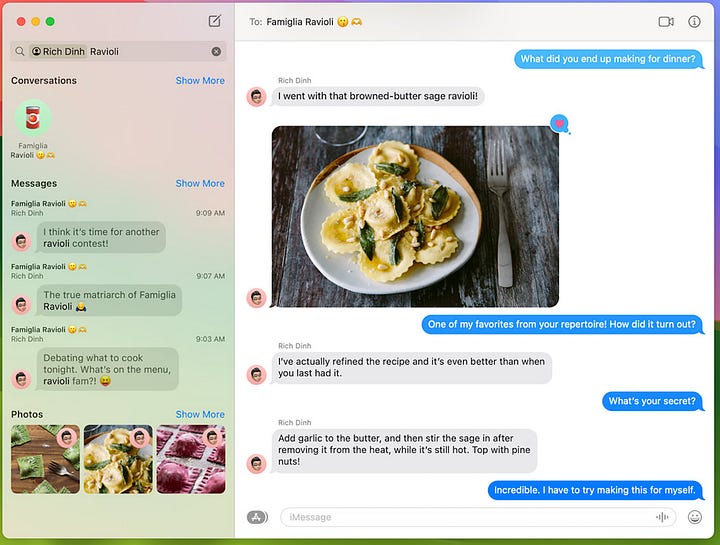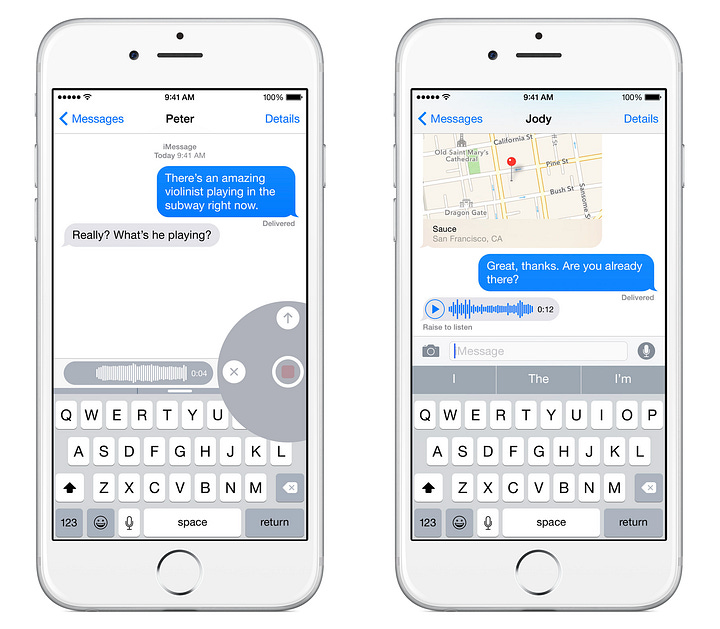A literary history of fake texts in Apple's marketing materials
Exploring the Applecore style
Like a lot of troubled young men, I used to pay close attention to Apple’s developer conferences and special announcements, eagerly anticipating each new generation of iPhone and operating system. In the 2000s and 2010s these regular public demonstrations were filled with suspense and anticipation What would the phones look like this year? Which executive would Steve Jobs personally execute in a windowless room immediately following the presentation? Would the new iPhone finally solve my problems and make me happy?
Here in 2023, that air of mystery and expectation is gone. Every phone looks the same; every announcement has been widely leaked. But there is still a good reason to attend to Apple’s marketing extravaganzas: The fake texts.
I’m talking about the mocked-up texts and emails Apple puts together to demonstrate new messaging features in its operating-system updates, presumably written by some well-paid professionals in Apple’s marketing department. These eerily cheery, aggressively punctuated messages suggest a alternate dimension in which polite, good-natured, rigorously diverse groups of friends and coworkers use Apple products exactly how they are designed to be used, without complaint or error. Here are some of the more recent examples of what I am talking about, used to tout this year’s updates, iOS 17 and MacOS Sonoma:


Every new update to Apple software brings along with it marketing materials populated by new casts of characters engaged in a new set of projects, but storylines are never elaborated, let alone resolved, and campaigns pass without any questions being answered. This year we have texts between an oddly formal soapbox derby team (???) and what seems to be a kind of stuffed-pasta club that is by all evidence annoyingly dominated by a man named Rich Dinh, taking suspiciously professional photographs of his own food:


If there is still mystery in Apple events, it is located here, in the uncanny fictional world suggested in these images: Who are these people? And what is wrong with them that they text like this?
A history of fake Apple texts, 2011-2023
A proper literary study of fake Apple texts has yet to be undertaken, but with the help of the Wayback Machine, we can sift through more than a decade’s work of marketing materials to identify certain trends and themes. For the sake of precision, let’s begin our survey in 2011, with the launch of iMessage in iOS 5. Here, so far as I can tell, is the first-ever fake Apple iMessage conversation:
Here, we see both sides of a chat between “Elisa Rossi” and “Greg Apodaca”12 in which Elisa sends Greg a photograph from her vacation. It is hard not to appreciate the rigidly orthographically correct banter between these … coworkers? Friends? The true nature of their relationship remains unclear.
Sharing photographs as Dimension Apple cultural practice
The main thing to note here is the photograph. There is nothing--nothing--that denizens of the Dimension Apple love more than sharing photographs with each other. One of the very few desires that people in these texts ever express is for their friends to share photos; “send photos” is the “Come to Brazil” or “show feet” of the Dimension Apple:
Photographs of what, you ask? In Dimension Apple, everyone is always spending the weekend together having fun, like Ken, Angela, and Fritz in iOS 73:
Or Ailish and Eden in iOS 8 (see the 9:27 a.m. email; note also the 8:17 a.m. email from Cory Quinn):
Or Paul, Natalia, Stefan, and the kids in iOS 9:
“How was the road trip?”
People are always taking trips in Dimension Apple, seemingly for the sole purpose of creating photographs to share via Apple software. They love to plan canoe trips and summer getaways and casual weekends in Santa Cruz; they form group chats centered around trips that only one participant was on:
Dimension Apple trip destinations have become increasingly vague, as the “Road Trip” group chat suggests, part of an overall and troubling vague-ening of the Dimension Apple. Are specific places disappearing in Dimension Apple? Are the edges of the map softening? How far can you drive, and where do you end up? Where did Nanditha and her friend go on their many “fun trips”? We may never know:
The vagueness was not always the case. In the early years, Dimension Appleites loved to take advantage of iMessage’s free international messaging by, e.g. chatting with their parents while studying abroad:
You might wonder why this Dimension Apple daughter is sending her mother such a professional and staged-looking photograph, but the other thing to understand about people who live in Dimension Apple is that they are serious photography hobbyists, and make frequent use of Apple software to edit their photos before sharing them. No wonder Rich Dinh’s ravioli photo looks so good:
Surprise!
The only thing that approaches “sharing photographs” as a key cultural practice in Dimension Apple is “planning parties.” When they are not emailing or texting to plan trips or share photographs, they are planning parties with one another:
Surprise parties in particular have huge importance to Dimension Apple characters, and the surprise party as a motif frequently re-occurs across iOS versions:
While birthdays and road trips are still a cornerstone of the socio-cultural world of Dimension Appleites, we increasingly get glimpses of their life outside the constant circle of parties and weekend getaways. Recent seasons prominently feature examples of intensely friendly collaboration on vague projects and presentations, all of which seem to exist in some nebulous zone between “work” and “volunteering,” like the “Pantry Co-Op” planned by a Group Chat mysteriously called “Foodies”:
Who knows what this presentation is about? Or why everyone is so enthusiastic about it?
The mystery of John Bishop
One rule of Dimension Apple is that there is no cross-over: The people who populate any given update are all new to that update, and never appear again in future marketing materials. “Rich Dinh” and “Trev Smith” are unique to iOS 17; “Sarah Castellbanco” and “Eden Sears” to iOS 8; etc.
With one exception: John Bishop.
Bishop--whose name seems to be borrowed from an Apple designer--first appears in iOS 10 as a contact auto-populated by Apple Mail. He is possibly a Cupertino-based contractor being recommended to a person named Eric Townley.
In most cases, this would be the last time we would ever see John Bishop’s name. But a year later, amidst the marketing materials for iOS 11, who should appear again but John himself?4
Who is John Bishop, the planeswalker who travels so casually from one iOS to the next? What other powers does he possess? And why does he hate Andrew so much?
Things that do not exist in Dimension Apple
The denizens of Dimension Apple love the following things: Punctuation, trips, sharing photographs, using emoji, taking photographs, surprise parties. You might be inclined to say that they hate roasts, bits, gossip, cynicism, text abbreviations like “LOL,” and other standard features of texting in our dimension--but it is not at all clear to me that any of these things even exist in Dimension Apple to be hated. Like Android users, irony simply does not occur in Dimension Apple.
Does the Dimension Apple exist?
For a long time I have enjoyed the stilted, improbable cheeriness of fake Apple texts for their extreme distance from my own texting habits and experiences. (As my friend Emma put it to our group chat “if any of you texted me like this I would immediately call your significant others to make sure you hadn’t been kidnapped.”) But in the last year or so I have realized that Dimension Apple does exist--or at least overlaps with our own--in one very specific place: The WhatsApp groups that the parents at my son’s daycare/school create to share information or set up play dates. In these groups, and only in these groups, do I encounter the same kind of earnest helpfulness and baffling ebullience that exists in the Dimension Apple. Naturally, I find them totally alienating.
The Read Max Library of Fake Apple Texts
To aid future study of the Dimension Apple, I’m publishing all the screenshots and images of fake Apple texts I was able to pull from the Wayback Machine below. Please share any theories, details, theses, etc. you develop from this corpus. Note that the Wayback Machine didn’t scrape any images from iOS 13, so we’re missing that update.
iOS 5


iOS 6


iOS 7
iOS 8


iOS 9
iOS 10








iOS 11





iOS 12
iOS 14





iOS 15
iOS 16





iOS 17








Italian-American excellence!
Quick Google searches suggest that all the names that appear in fake Apple texts are the real names of Apple employees and contractors from across the company, which to me has got to be a huge employment perk.
One interesting thing about this image is that it’s the only one where an email forward appears. Even more bizarrely, no email subject lines in Dimension Apple ever begin with “re:” Does everyone in Dimension Apple simply type a new subject line in ever email reply?
There’s more to say about this image in general--ostensibly it’s showing off the ability to read email while you’re FaceTiming, but why is Eden reading this melancholy email from her old coworker Sarah while FaceTiming with someone in Yosemite?
Bishop appears only in an image from the iOS 11 preview page that went up before it was officially released--the image was later changed to remove his text message.




































I wish I could remember where I heard someone describe the imagined Apple customer persona in these videos as "California Man," the guy who tracks his workouts, creates intricate shared photo libraries on his iPad, goes to Hawaii on the regular, records his daughter's birthday using augmented reality goggles, etc.
Rich is a liar, those sage leaves were fried